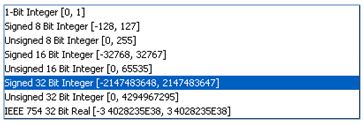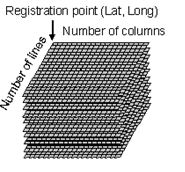This is an old revision of the document!
LESSON 1: Dinamica EGO data structures and file format
What will you learn?
- Dinamica EGO data structures
- Dinamica EGO file formats
Dinamica EGO handles data in several formats, including raster maps or images, tables, matrices, and a Weights of Evidence coefficient file.
For spatial data, Dinamica only supports raster datasets. Therefore you will need to prepare your dataset in a GIS package and then export the maps in one of the three formats specified below. Although geo-referencing is supported and needed, all raster dataset in a model must have the same number of columns and rows. Moreover they must be tied to the same coordinate space and registration point (Fig.3).
Dinamica EGO reads and writes raster data in many ways: check all the Supported Map Formats
Dinamica EGO supports all the affine coordinate systems wich includes most of the projections and datums used.

Usually, the lowest negative value is used to represent the null value. For example -32768 for Signed 16 Bit Integer. Always choose a data cell type able to embrace the range of values contained in a variable. For example: elevation, varying from -10 meters to 4000 meters, must be represented as Signed 16 Bit Integer or IEEE 754 32 Bit Real.
Tables are a convenient way to represent attribute data, usually pertaining to a certain geographic zone, for example: country, state or counties. Dinamica EGO can read data in Comma Separated Value format, as follows. Basically, it is possible to use two different kinds of tables: tables and lookup tables.
Table
| Key* | Key2* | Value | Value2 |
|---|---|---|---|
| 1 | 2 | 10 | 60 |
| 2 | 6 | 30 | 40 |
| 3 | 9 | 15 | 20 |
Lookup Table
| Key | Value |
|---|---|
| 1 | 10 |
| 2 | 30 |
| 3 | 15 |
The first line of the lookup table must contain the columns titles “Key” and the variable name, such as population, countries, etc.
Transition matrix is also stored using this format as follows:
| To* | From* | Rate |
|---|---|---|
| 1 | 2 | 0.223567 |
| 1 | 3 | 0.223567 |
| 2 | 1 | 0.024841 |
| 2 | 3 | 0.030573 |
| 3 | 2 | 0.000348 |
Thus the previous table is equivalent to the following transition matrix: Note that the diagonal values do not need to be filled in, nor are necessary the transitions equal to zero.
| 1 | 2 | 3 | |
|---|---|---|---|
| 1 | - | 0.223567 | 0.379618 |
| 2 | 0.024841 | - | 0.030573 |
| 3 | 0 | 0 | - |
Another supported format is the Weights of Evidence file - a text file containing the Weights of Evidence coefficients. This file is obtained through the Weights of Evidence method used in the calibration process

